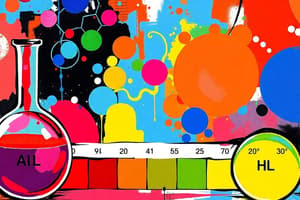Podcast
Questions and Answers
What are bases?
What are bases?
A substance that forms when metals react with water.
What are acids?
What are acids?
A substance that reacts with metals and releases hydrogen.
What is the pH scale?
What is the pH scale?
The pH scale measures how acidic or basic a substance is.
What is the range of the pH scale?
What is the range of the pH scale?
What range on the pH scale indicates that a substance is an acid or base?
What range on the pH scale indicates that a substance is an acid or base?
What is an indicator?
What is an indicator?
Give an example of an indicator used to test acids.
Give an example of an indicator used to test acids.
What color do acids change blue and red litmus paper?
What color do acids change blue and red litmus paper?
When acids mix with most metals, what type of gas is given off?
When acids mix with most metals, what type of gas is given off?
What type of taste do acids have?
What type of taste do acids have?
What type of taste do bases have?
What type of taste do bases have?
What color do bases turn red and blue litmus paper?
What color do bases turn red and blue litmus paper?
What does phenolphthalein indicate for acids and bases?
What does phenolphthalein indicate for acids and bases?
How do acids and bases affect metal?
How do acids and bases affect metal?
What characteristics do acids and bases share?
What characteristics do acids and bases share?
If you touch a harmless base, how will it feel?
If you touch a harmless base, how will it feel?
Do acids have any special feel?
Do acids have any special feel?
What is the name of the base that can be found in soap?
What is the name of the base that can be found in soap?
Is vinegar an example of an acid or base?
Is vinegar an example of an acid or base?
Is ammonia an example of an acid or base?
Is ammonia an example of an acid or base?
Flashcards are hidden until you start studying
Study Notes
Acids and Bases Overview
- Bases are substances formed when metals react with water.
- Acids react with metals, releasing hydrogen gas during the reaction.
pH Scale
- The pH scale measures acidity or basicity, with a range from 0 to 14.
- A pH of 7 indicates neutrality; pH below 7 indicates acidity, while pH above 7 indicates basicity.
Indicators
- Indicators are substances that change color in response to acids or bases.
- Litmus paper is a common indicator: it turns blue litmus paper red in the presence of acids and does not change red litmus paper.
- Phenolphthalein serves as another indicator; it turns clear for acids and deep pink for bases.
Taste and Feel
- Acids have a sour taste, whereas bases possess a bitter taste.
- Bases, like soap, feel slippery; acids do not have any distinctive feel.
Effects on Metal and Safety
- Acids can corrode or wear away metals, while bases do not affect metals in the same way.
- Both acids and bases can have varying strengths and may be dangerous to touch or taste.
Common Examples
- Vinegar is identified as an acid, while ammonia is recognized as a base.
- Soap contains a base known as lye.
Reaction with Metals
- When acids mix with metals, hydrogen gas is released as a byproduct.
Studying That Suits You
Use AI to generate personalized quizzes and flashcards to suit your learning preferences.





